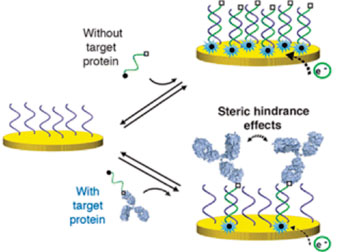Rapid, Simple, Inexpensive Diagnostic Tests Developed Using DNA
By LabMedica International staff writers
Posted on 13 Oct 2015
A highly selective DNA-based electrochemical sensor that utilizes steric hindrance effects to signal the presence of large macromolecules in a single-step procedure has been developed.Posted on 13 Oct 2015
Electrochemical test's sensing principle may be generalized to many different targets, leading to inexpensive devices that could detect dozens of disease markers in less than five minutes. A large macromolecule, such as a protein, when bound to a signaling DNA strand generates steric hindrance effects, which limits the ability of this DNA to hybridize to a surface-attached complementary strand.

Image: Schematic representation of DNA-based electrochemical sensor (Photo courtesy of University of Montreal).
Scientists at the University of Montreal (QC, Canada) and their Italian colleagues used DNA molecules to developed rapid, inexpensive medical diagnostic tests that take only a few minutes to perform. Their findings, may aid efforts to build point-of-care devices for quick medical diagnosis of various diseases ranging from cancer, allergies, autoimmune diseases, sexually transmitted diseases (STDs), and many others.
They demonstrated that the efficiency of hybridization of this signaling DNA was inversely correlated with the size of the molecule attached to it, following a semi-logarithmic relationship. Using this steric hindrance hybridization assay in an electrochemical format (eSHHA), they demonstrated the multiplexed, quantitative, one-step detection of various macromolecules in the low nanomolar range, in less than 10 minutes directly in whole blood. The sensing principle was straightforward as the diagnostically relevant protein (green or red), if present, binds to an electro-active DNA strand, and limits the ability of this DNA to hybridize to its complementary strand located on the surface of a gold electrode.
Sahar Mashid, PhD, the first author of the study, said, “While working on the first generation of these DNA-base tests, we realized that proteins, despite their small size are big enough to run into each other and create steric effect (or traffic) at the surface of a sensor, which drastically reduced the signal of our tests. Instead of having to fight this basic repulsion effect, we instead decided to embrace this force and build a novel signaling mechanism, which detects steric effects when a protein marker binds to the DNA test.” The study was published online on September 4, 2015, in the Journal of the American Chemical Society.
Related Links:
University of Montreal













